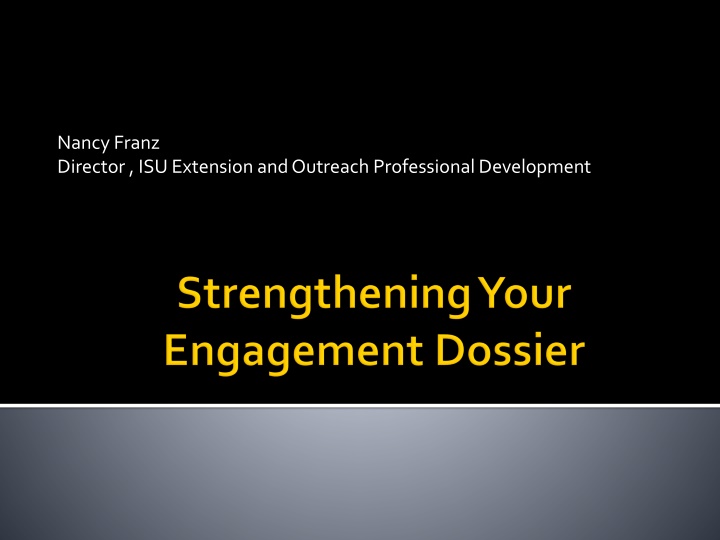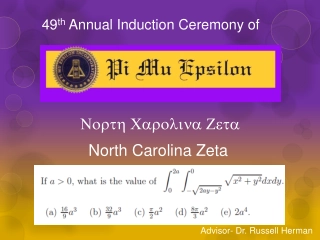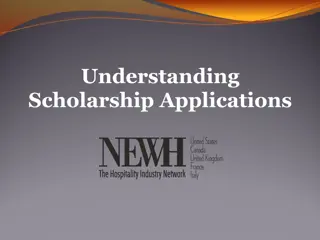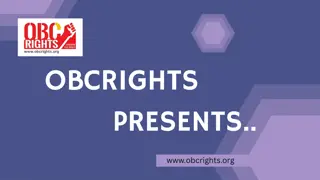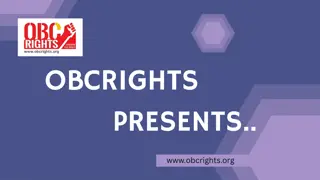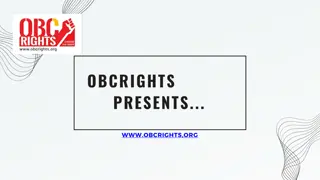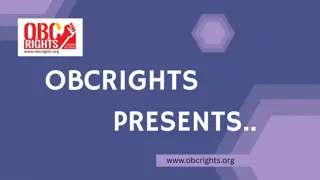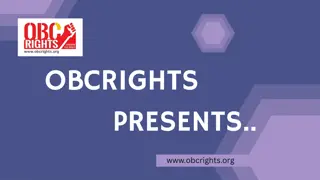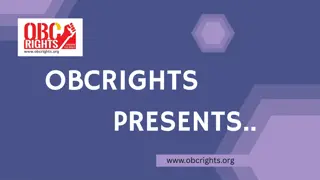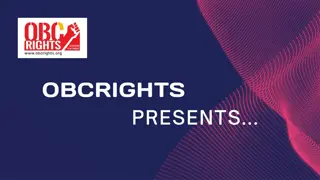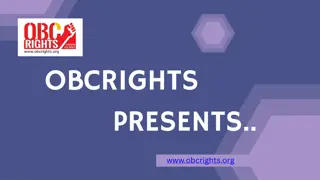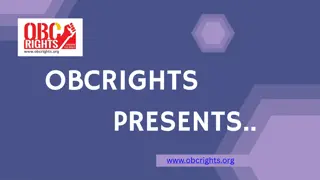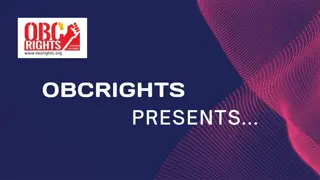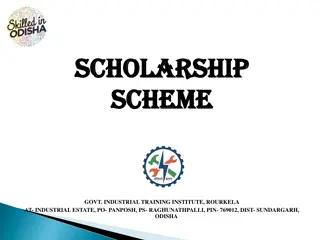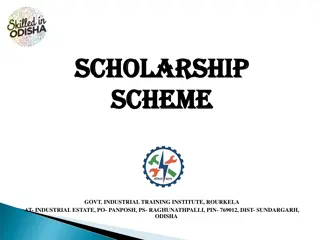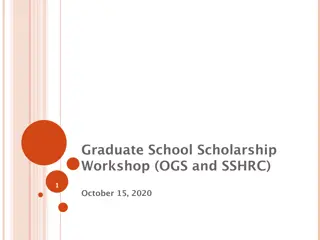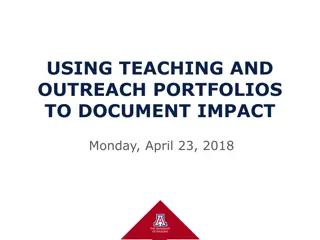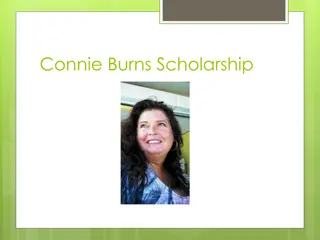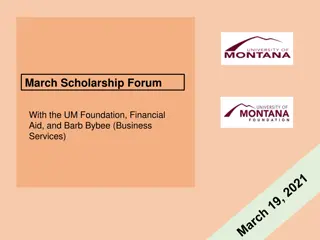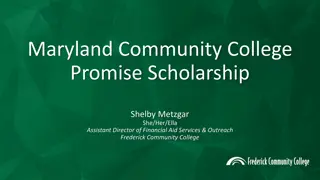Engaged Scholarship and Empowering Change
Nancy Franz, Director of ISU Extension and Outreach, shares her 32-year journey in Cooperative Extension across multiple states. Explore her valuable insights on tenure, promotion, and academic engagement, along with her passion for sports, gardening, and dark chocolate. Dive into the principles of engagement and scholarship, enhancing research and teaching to make a meaningful impact on social, economic, and environmental issues. Discover the Franz Engaged Scholarship Model, emphasizing internal and external factors that drive research, teaching, and outreach for positive change.
Download Presentation

Please find below an Image/Link to download the presentation.
The content on the website is provided AS IS for your information and personal use only. It may not be sold, licensed, or shared on other websites without obtaining consent from the author.If you encounter any issues during the download, it is possible that the publisher has removed the file from their server.
You are allowed to download the files provided on this website for personal or commercial use, subject to the condition that they are used lawfully. All files are the property of their respective owners.
The content on the website is provided AS IS for your information and personal use only. It may not be sold, licensed, or shared on other websites without obtaining consent from the author.
E N D
Presentation Transcript
Nancy Franz Director , ISU Extension and Outreach Professional Development
Nancys engagement journey 32 years with Cooperative Extension in Wisconsin, New York, New Hampshire, Virginia, and Iowa Many positions and departments Three times up for tenure/promotion Help many others up for tenure/promotion Chair of P&T committee and member at all levels External dossier reviewer 3-5 annually Silent sports, reading, gardening, dark chocolate
Your name Position Institution Tenure/promotion journey
Engaged scholarship Faculty voices on engagement and engaged scholarship Engaged scholarship P&T resources Documentation of engagement in the academic dossier Best practices list Other good engagement stuff
Enhance research Enhance teaching Student growth and development Scholar growth and development Address social, economic, and environmental issues Make a difference in the world
Approaches to Engagement and Scholarship SCHOLARSHIP LOW HIGH Engagement Engaged Scholarship E N G A G E M E N T Mutual benefit Exchange knowledge/resources Reciprocal partnership Principles of engagement + Principles of scholarship HIGH Service Scholarship One way/expert presentation to groups Internal committees Professional associations Original intellectual work Communicated Validated by peers LOW Dr. Nancy Franz 2009
Figure 1. Franz Engaged Scholarship Model Figure 1. Franz Engaged Scholarship Model Internal and External Factors Research Develop knowledge Disseminating knowledge Discover knowledge Teaching Academia community legacy that grows the field Condition Change Learning change Behavior change Outreach Engagement Assumptions
At your table, review the research report about engagement at Virginia Tech What surprised you What insights do you see for P&T What messages do you see from the faculty What other data do you find interesting
Making Outreach Visible: A Guide to Documenting Professional Service and Outreach (1999) Driscoll and Lynton Uniscope Penn State Journal of Extension (2008, 46(4), O Neill) New Directions for Evaluation (2008, #118, Chapter 1, Jordan, Hage, Mote) Scholarship Assessed (1997, Glassick et al) The Disciplines Speak (1995, Diamond & Adam)
New Directions for Institutional Research (2002, #114, Colbeck) Community Engaged Scholarship (2005, Calleson et al.) Higher Education Exchange (2006, Barker) Journal of Higher Education Outreach and Engagement Community Campus Partnership for Health www.communityengagedscholarship.info
The Academic Portfolio (2009) (Sheldin and Miller) Campus compact www.compact.org Promotion, Tenure, and the Engaged Scholar (2002) in AAHE Bulletin (Gelmon and Agre- Kippenhan) Principles of Best Practices for Community- Based Research (2003) (Strand, Marullo, Cutforth, Stoecker, and Donohue)
Map your efforts Determine what impact will be measured Collect and analyze data Tell your story
Situation Inputs Outputs Outcomes Assumptions External Factors
Text Concept Map http://en.wikipedia.org/wiki/Concept_map Logic Model http://www.uwex.edu/ces/pdande/evaluation/ pdf/LMfront.pdf
Processes used in your educational efforts to report program/teaching/research quality Products from your educational/research efforts to report impact on individuals and communities Performance of the instructor/researcher for personal and program/teaching/research quality
What new knowledge was discovered, developed, disseminated? What did participants learn? How have participant aspirations or motivations changed due to the program? (i.e. intent to change behavior) What are participants doing differently as a result of the program? How much have economic, environmental, or social conditions changed due to your efforts?
Peer products Articles Conferences Posters Presentations Abstracts proceedings Grants/competitive contracts Books/texts/chapters/monographs
Applied products Curricula/texts Educational materials Guides/handbooks Policies Research briefs Social marketing/Apps Training and technical assistance
Community Products Forums/workshops /seminars Newsletters Web sites Presentations Reports Designs Displays Community attained grants/funding Community awards
Off campus service learning Internships/practicum/clinical Coop positions with organizations/agencies/companies Deliberation/public scholarship Student led/assisted community seminars/forums/deliberation Community study tour Community projects Community-based participatory action research Participatory or empowermentevaluation
Case Study Observation Focus Group/Interview Secondary Data Survey/Questionnaire
Title Relevance Response Results See: http://connect.ag.vt.edu/impactwr iting
Glassick et al. (1997) - Clear goals - Adequate preparation - Appropriate methods - Significant results - Effective presentation - Reflective critique
ISU tenure guidelines - Documentation of candidate s scholarship and position responsibilities - Definition of scholarship - Effectiveness in areas of responsibility - other
Diamond and Adam - High level of discipline-related experience - Break new ground/innovative - Can be replicated or elaborated - Can be documented - Can be peer reviewed - Significant impact
At your table: - What do you see as dossier review criteria at your institution? - What matters? - Other thoughts about dossier review?
Ultimately, RPT decisions rest on values and judgments, not on measurement or clear expectations. Fairweather New Directions for Institutional Research (2002, #114, pg. 97)
Virginia Tech Focus Groups At your table review the article on engagement at Virginia Tech What does this context value for tenure and promotion? What are the challenges for engaged faculty to gain support? What supports are in place for engaged scholarship? Other observations
How does your institutions mission align with your work? How do your institution s measures of assessment fit with your work? How does your institution s strategic plan mesh with your work? What is your academic appointment? What is your contribution to your discipline, department, college, institution?
At your table: Record the engagement P&T best practices you ve gleaned from today s discussions and materials. Share them with the group
Start early engagement takes time Documentation is an ongoing process Write for an academic audience Focus on faculty work, not on the project Find a balance between process and impact/products Be clear about the intellectual question or working hypothesis behind the work Tell the significance of the impact and how it is determined or evaluated
Align engagement with discipline, department, campus, and national priorities Share only the information that illustrates context or scholarship Link current and past work with future work Select mentors and learn the criteria used for your review Know the expected format for the dossier Get to know your dossier reviewers and their expectations
Create a documentation file system Develop a disciplinary, department, and eventually national niche Publish and present early and often Select service roles carefully and turn them into scholarship Make activities that matter a high priority (i.e. writing) Demonstrate value in all you do
Focus Be new, the first, or better than others Be aware of what influences faculty scholarly work and manage it (i.e. assignment, rewards, time, resources, personal priorities, performance review, P&T documents, culture) Engage many peer reviewers as you go Find ways to bridge the gaps between tenure expectations and the actual day to day work of faculty Reach more than one goal with each activity/project and get maximum products out of each effort
Use each other as resources on the tenure trail Attend NOSC Celebrate success Keep in touch
